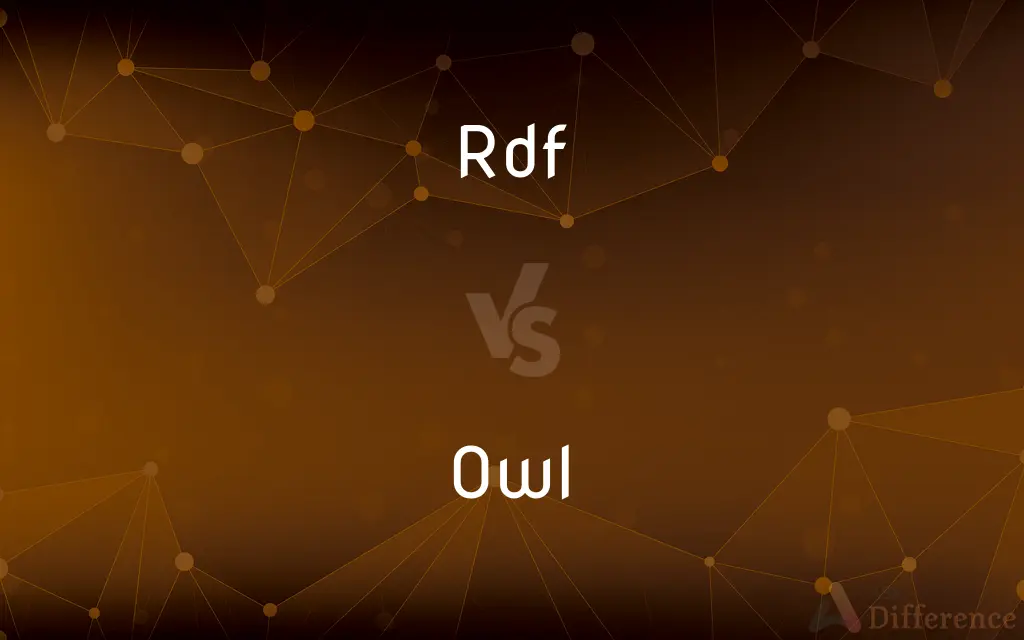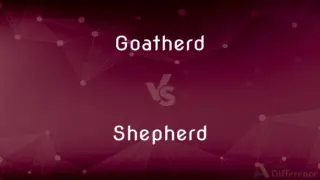RDF vs. OWL — What's the Difference?
By Tayyaba Rehman & Fiza Rafique — Updated on March 25, 2024
RDF is a framework for representing information on the web, focusing on data relationships, while OWL is an ontology language extending RDF with more complex relationships and classes.

Difference Between RDF and OWL
Table of Contents
ADVERTISEMENT
Key Differences
RDF, or Resource Description Framework, is a standard model for data interchange on the web, emphasizing the relationships among data. It uses triples, consisting of a subject, predicate, and object, to represent data as a graph. RDF is foundational for semantic web applications, allowing data to be mixed, exposed, and shared across different applications. OWL, or Web Ontology Language, builds upon RDF and RDF Schema (RDFS), introducing more vocabulary for describing properties and classes. OWL is designed for applications that need to process the content of information instead of just presenting it.
RDF is particularly suited for modeling simple relationships between entities, making it an excellent tool for linking data fragments across the web. Its straightforward triple-based structure facilitates the representation of statements about resources. RDF's simplicity is one of its greatest strengths, making it accessible and easily adoptable for a wide range of applications.
OWL, on the other hand, caters to applications requiring more expressive power, such as those needing to represent complex relationships or enforce data integrity through constraints. OWL ontologies allow for the definition of detailed and sophisticated hierarchies and relationships, providing mechanisms for classification and inference, which are not possible with RDF alone.
While RDF serves as the backbone of the semantic web, providing a simple yet powerful framework for data interchange, OWL extends this framework to accommodate more complex relationships and logic. This complementary relationship between RDF and OWL is crucial for the development of semantically rich and interoperable web applications.
Comparison Chart
Type
Data interchange model
Ontology language
ADVERTISEMENT
Base
Uses triples: subject, predicate, object
Extends RDF and RDFS
Purpose
To represent simple relationships among data
To enable complex relationships and classes
Expressiveness
Limited to basic relationships
More expressive, with advanced features for reasoning
Use Case
Linking data across the web
Complex data modeling and ontology development
Compare with Definitions
Rdf
RDF uses a triple structure, comprising a subject, predicate, and object, to represent data as a graph.
In RDF, The Earth (subject) has (predicate) One Moon (object).
Owl
OWL extends RDF and RDFS, providing additional vocabulary for more complex ontology development.
OWL includes terms for describing properties such as symmetry, transitivity, and equivalence.
Rdf
RDF Schema provides a basic ontology framework to structure RDF resources.
RDF Schema defines classes and properties that are used in RDF data.
Owl
OWL is used in applications requiring advanced reasoning and logic capabilities.
In OWL, it's possible to infer that if A is a part of B and B is a part of C, then A is also a part of C.
Rdf
RDF stands for Resource Description Framework, a standard for encoding, exchanging, and reusing structured metadata.
RDF describes the director of a movie as a relationship between the movie and the person.
Owl
OWL stands for Web Ontology Language, designed for representing rich and complex information about things and the relationships between them.
OWL can define a Person class with related properties like hasSibling.
Rdf
RDF is foundational for semantic web applications, enhancing data interoperability.
RDF allows different web resources to understand and use each other's data seamlessly.
Owl
OWL ontologies enable classification and inferencing, allowing for more dynamic data interpretation.
OWL can classify an individual as a Student based on their enrollment in a course.
Rdf
RDF facilitates linking among data across different systems.
RDF links a person's profile from one database to their publication in another.
Owl
OWL supports three sublanguages - OWL Lite, OWL DL, and OWL Full - offering different levels of expressiveness.
OWL Full provides maximum expressiveness and the least computational tractability.
Rdf
(maths) radial distribution function
Owl
Owls are birds from the order Strigiformes , which includes over 200 species of mostly solitary and nocturnal birds of prey typified by an upright stance, a large, broad head, binocular vision, binaural hearing, sharp talons, and feathers adapted for silent flight. Exceptions include the diurnal northern hawk-owl and the gregarious burrowing owl.
Owl
Any of various often nocturnal birds of prey of the order Strigiformes, having hooked and feathered talons, a large head with a short hooked beak, large eyes set forward, and fluffy plumage that allows for almost noiseless flight.
Owl
Any of several breeds of domestic pigeons having a very short beak somewhat like that of an owl and often a frill of feathers on the chest.
Owl
Any of various birds of prey of the order Strigiformes that are primarily nocturnal and have forward-looking, binocular vision, limited eye movement, and good hearing.
Owl
(by extension) A person seen as having owl-like characteristics, especially appearing wise or serious, or being nocturnally active.
Owl
An owl pigeon.
Owl
A politician with moderate views that are neither hawkish nor dovish.
Owl
Any of various nymphalid butterflies, especially in the genus Caligo, having large eyespots on the wings.
Owl
To smuggle contraband goods.
Owl
Any species of raptorial birds of the family Strigidæ. They have large eyes and ears, and a conspicuous circle of feathers around each eye. They are mostly nocturnal in their habits.
Owl
A variety of the domestic pigeon.
Owl
To pry about; to prowl.
Owl
To carry wool or sheep out of England.
Owl
Hence, to carry on any contraband trade.
Owl
Nocturnal bird of prey with hawk-like beak and claws and large head with front-facing eyes
Common Curiosities
What is RDF used for?
RDF is used for representing information on the web, particularly the relationships among data entities.
Can OWL be used without RDF?
OWL is built upon RDF and RDF Schema, so it inherently uses RDF's framework for data representation.
How does OWL extend RDF?
OWL extends RDF by providing additional vocabulary and a richer framework for representing complex relationships and classes.
What are the sublanguages of OWL?
OWL includes three sublanguages: OWL Lite, OWL DL, and OWL Full, each offering different levels of expressiveness and computational efficiency.
How does RDF Schema relate to RDF?
RDF Schema provides a basic ontology system to structure and categorize RDF data, introducing concepts like classes and properties.
What is the role of triples in RDF?
Triples in RDF serve as the basic building blocks, representing data in a subject-predicate-object format, enabling a graph-based data structure.
What makes RDF unique in the semantic web?
RDF's unique triple-based model allows for a flexible and straightforward representation of data relationships, making it foundational for linking disparate web data.
How does RDF handle data interchange?
RDF uses a simple graph-based structure, enabling data to be easily mixed, shared, and interpreted across different applications.
Is OWL compatible with all RDF data?
OWL is designed to work seamlessly with RDF data, extending its capabilities for more complex data structures and logic.
How do RDF and OWL contribute to the semantic web?
RDF and OWL are foundational technologies of the semantic web, enabling structured data to be linked and shared, thereby enhancing the web's usability and intelligence.
What types of applications benefit most from OWL?
Applications requiring complex data modeling, advanced reasoning, and ontology development benefit most from OWL's expressive power.
How does OWL facilitate data reasoning?
OWL provides mechanisms for defining complex relationships, enabling automated reasoning and inference about the data.
What are the primary use cases for RDF?
RDF is widely used for linking data across the web, facilitating interoperability and reusability of data among different web resources.
Can RDF represent complex relationships like OWL?
RDF can represent basic relationships, but OWL is required for more complex interrelations and logic-based reasoning.
Share Your Discovery

Previous Comparison
Single vs. Singular
Next Comparison
Goatherd vs. ShepherdAuthor Spotlight
Written by
Tayyaba RehmanTayyaba Rehman is a distinguished writer, currently serving as a primary contributor to askdifference.com. As a researcher in semantics and etymology, Tayyaba's passion for the complexity of languages and their distinctions has found a perfect home on the platform. Tayyaba delves into the intricacies of language, distinguishing between commonly confused words and phrases, thereby providing clarity for readers worldwide.
Co-written by
Fiza RafiqueFiza Rafique is a skilled content writer at AskDifference.com, where she meticulously refines and enhances written pieces. Drawing from her vast editorial expertise, Fiza ensures clarity, accuracy, and precision in every article. Passionate about language, she continually seeks to elevate the quality of content for readers worldwide.













































